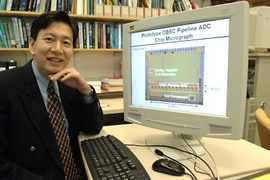Advances in digital electronic circuits have prompted the boost in functions and ever- smaller size of such popular consumer goods as digital cameras, MP3 players and digital televisions. But the same cannot be said of the older analog circuits in the same devices, which process natural sights and sounds in the real world. Because analog circuits haven't enjoyed a similar rate of progress, they are draining power and causing other bottlenecks in improved consumer electronic devices.
Now MIT engineers have devised new analog circuits they hope will change that. Their work was discussed at the International Solid State Circuits Conference (ISSCC) in San Francisco Feb. 11-15.
"During the past several decades engineers have focused on allowing signals to be processed and stored in digital forms," said Hae-Seung Lee, a professor in MIT's Microsystems Technology Laboratories (MTL) and the Department of Electrical Engineering and Computer Science (EECS). "But most real-world signals are analog signals, so analog circuits are an essential part of most electronic systems."
Analog circuits are used to amplify, process and filter analog signals and convert them to digital signals, or vice versa, so the real world and electronic devices can talk to each other. Analog signals are continuous and they vary in size, whereas digital signals have specific or discrete values.
The reason the two different types of electronic signal circuits did not advance at the same pace, Lee said, is because they are very different. Digital circuits can be decreased in size more easily, for example, by using the popular complementary metal oxide semiconductor (CMOS) technology. And much of the design and performance enhancement can actually be done by computer software rather than by a human. That's not the case with analog circuits, which Lee said require clever designs by humans to be improved because of their variable nature.
"There is a lot of room for innovation in the human design," he said. "The importance of analog circuits is growing in light of the digital improvements, so engineers can make a difference in products by working on them." Currently, analog circuits are rather expensive and they consume a disproportionate amount of power compared with digital circuits.
Another blow to analog circuits is that the advancements in fabrication (manufacturing) technology to improve digital circuits have had a negative impact on them. Traditionally, many conventional analog circuits have relied upon devices known as operational amplifiers. Two negative side effects that advanced fabrication technologies have had on operational amplifier-based analog circuits are that when used in consumer or other devices, they have reduced the range of the analog signal and decreased the device's gain. To compensate for these shortcomings, analog circuits must consume much more power, thus draining precious energy from batteries.
In addition, it still is not clear whether traditional operational amplifier-based circuits can be applied to emerging technologies such as carbon nanotube/nanowire devices and molecular devices.
Lee's research group, in collaboration with Professor Charles Sodini's group in MIT's MTL and EECS, recently demonstrated a new class of analog circuits that Lee said eliminates operational amplifiers while maintaining virtually all benefits of operational amplifier-based circuits. These new comparator-based switched capacitor (CBSC) circuits handle voltage differently than conventional analog ones, resulting in greater power efficiency.
"The new work coming out of MIT offers the intriguing possibility of eliminating operational amplifiers by proposing an architecture that relies on circuit blocks that are much more readily implemented on supply voltages of 1 volt or less," said Dave Robertson, high-speed converter product line director at Analog Devices Inc. in Norwood, Mass., and data converter subcommittee chair at ISSCC.
Lee said CBSC may enable high-performance analog circuits in emerging technologies because it would be easier to implement comparators than operational amplifiers in these technologies.
The first prototype MIT CBSC was demonstrated in an analog-to-digital converter and presented at 2006 ISSCC. The second prototype, an 8-bit, 200 MHz analog-to-digital converter, will be presented at the conference this month.
Other key members of the research team are EECS graduate students John Fiorenza and Todd Sepke, who were involved in the work presented in 2006; EECS graduate student Lane Brooks, who worked on the current prototype; and Peter Holloway of National Semiconductor Corp.
The research leading to the 2006 ISSCC paper was funded by Microelectronics Advanced Research Corp. The research leading to the paper presented this month was funded by the MIT Center for Integrated Circuits and Systems and a National Defense Science and Engineering Graduate Fellowship.
A version of this article appeared in MIT Tech Talk on February 28, 2007 (download PDF).







